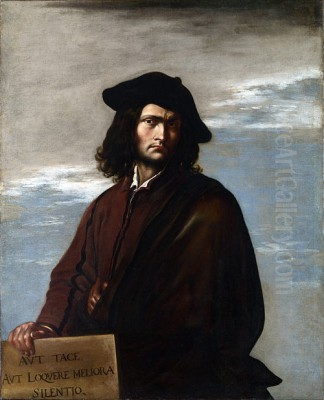
Salvator Rosa stands as one of the most intriguing and unconventional figures of the Italian Baroque era. Born in 1615 and passing away in 1673, he was far more than just a painter. Rosa was a prolific poet, a biting satirist, a talented musician, and an occasional actor. His life was as dramatic and tempestuous as his art, marked by rebellion, controversy, and a restless movement between the major artistic centers of Italy. Primarily known today for his evocative and often turbulent landscape paintings, Rosa carved a unique path, distinct from both the high classicism and the exuberant decoration often associated with the period. His work, imbued with a sense of wildness, melancholy, and the sublime, resonated deeply with later generations, particularly the Romantics, who saw him as a kindred spirit, an artist who dared to explore the darker, untamed aspects of nature and the human condition.
Early Life and Neapolitan Formation
Salvator Rosa entered the world in Arenella, a village on the outskirts of Naples, in 1615. Naples at this time was a vibrant, chaotic, and artistically fertile city under Spanish rule. His initial education pointed towards a religious life, as he spent some time in a monastery. However, the young Rosa's true passion lay elsewhere. Art called to him, and he soon embarked on formal training in the bustling artistic environment of Naples.
A pivotal moment in his development was his apprenticeship under Jusepe de Ribera, the Spanish-born painter known affectionately as "Lo Spagnoletto." Ribera was a dominant force in Neapolitan art, renowned for his dramatic realism, intense chiaroscuro inherited from Caravaggio, and often gritty depictions of saints, martyrs, and philosophers. Studying with Ribera undoubtedly exposed Rosa to powerful techniques of dramatic lighting and emotional intensity, elements that would become hallmarks of his own mature style.
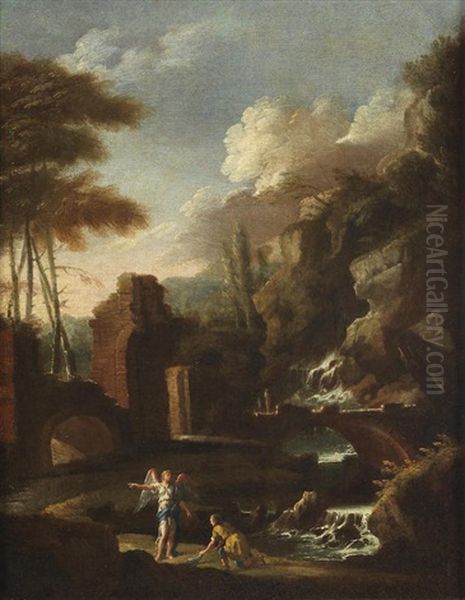
Beyond Ribera, the Neapolitan art scene offered other influences. Aniello Falcone, a contemporary known for his dynamic battle scenes, likely impacted Rosa's later interest in depicting soldiers, bandits, and scenes of conflict. The legacy of Caravaggio, who had spent time in Naples decades earlier, still permeated the city's artistic atmosphere, fostering a taste for realism, strong contrasts, and psychologically charged subjects. This Neapolitan crucible – a mix of Spanish severity, Caravaggesque drama, and local vibrancy – shaped Rosa's early artistic sensibilities, instilling in him a penchant for the dramatic and the emotionally resonant.
Roman Sojourns and Florentine Interlude
Like many ambitious artists of his time, Rosa sought recognition and patronage in Rome, the epicenter of the Baroque art world. He made his first significant foray into the city around 1635, returning more permanently a few years later. Rome offered immense opportunities but also fierce competition. Rosa initially found success, particularly with his landscape paintings, which offered a novel alternative to the prevailing styles. His depictions of wild, untamed nature quickly garnered attention.
However, Rosa's fiercely independent and outspoken nature soon led to trouble. He possessed a sharp wit and a satirical bent, which he did not hesitate to employ, even against the most powerful figures in the Roman art establishment. A famous incident occurred during Carnival in 1639 when Rosa, performing in a commedia dell'arte troupe, delivered a scathing satirical performance that openly mocked the renowned sculptor and architect Gian Lorenzo Bernini, a favorite of the papal court. This audacious act caused a scandal and made powerful enemies, effectively forcing Rosa to leave Rome for a time.
He found refuge in Florence, where he spent nearly nine years (c. 1640-1649) under the protection of the Medici family, particularly Cardinal Gian Carlo de' Medici. Florence provided a different intellectual and artistic climate. Rosa became a prominent member of a literary and philosophical circle known as the Accademia dei Percossi ("Academy of the Stricken"), where he could indulge his talents for poetry, satire, and intellectual debate alongside like-minded individuals. This period was crucial for developing his literary voice and solidifying his image as a multi-talented, anti-establishment figure. Despite the stimulating environment, Rosa eventually grew restless and sought a return to the larger stage of Rome, which he achieved around 1649, remaining there for the rest of his life.
The Unconventional Artist: Poet, Satirist, Actor
Salvator Rosa's identity cannot be fully grasped by focusing solely on his painting. He was a true polymath, embodying the Baroque era's fascination with diverse forms of expression, yet channeling them through a uniquely critical and independent lens. His activities beyond the canvas were not mere hobbies; they were integral parts of his artistic persona and his engagement with the world.
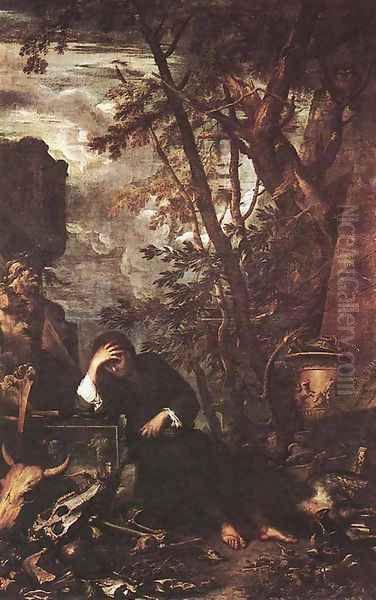
His poetry, often satirical, circulated widely, sometimes in manuscript form. These works frequently targeted the vanities of society, the corruption he perceived in institutions, the pretensions of art critics, and the follies of patrons. His satires, such as "La Pittura" (Painting) and "La Guerra" (War), reveal a sharp, critical mind and a deep disillusionment with many aspects of contemporary life and the art world. He lamented the lack of appreciation for serious historical or philosophical subjects in painting, compared to the demand for decorative or flattering works.
His theatrical activities, particularly his involvement with commedia dell'arte troupes, provided another outlet for his satirical impulses, as demonstrated by the infamous Bernini incident. He was known to be a charismatic performer, capable of captivating audiences with his wit and stage presence. This performative aspect extended to his public persona; he carefully cultivated an image of himself as a proud, independent philosopher-artist, disdainful of convention and flattery. This multi-faceted creativity set him apart from many contemporaries who focused solely on painting, contributing significantly to the mystique and controversy that surrounded him.
Artistic Style: The Sublime and the Savage
Salvator Rosa's most enduring contribution to art history lies in his distinctive approach to landscape painting. He broke decisively with the prevailing modes of his time. While artists like the French expatriate Claude Lorrain, working in Rome, perfected the idealized, pastoral landscape bathed in golden light, evoking a serene, classical Arcadia, Rosa offered a starkly different vision. His landscapes are rarely peaceful or idyllic; instead, they are wild, rugged, and often menacing.
Rosa depicted craggy mountains piercing turbulent skies, deep gorges shrouded in shadow, ancient, storm-blasted trees clinging precariously to rocky outcrops, and rushing torrents. Human figures, when present, are often dwarfed by the immensity and power of nature – small bandits lurking in ambush, solitary hermits seeking refuge, or weary travelers navigating perilous terrain. This was not the tamed nature of classical pastoralism but something untamed, powerful, and potentially dangerous.
His style is often associated with the concept of the "sublime," an aesthetic quality related to experiences that inspire awe, wonder, and even a degree of terror. It evokes feelings of grandeur and power that transcend the merely beautiful. Rosa's landscapes, with their dramatic contrasts of light and shadow (chiaroscuro), energetic brushwork, and emphasis on nature's raw power, perfectly encapsulate this quality. He also painted dramatic seascapes, often depicting shipwrecks and stormy waters, further exploring themes of nature's destructive force and human vulnerability. His unique vision offered a powerful counterpoint to the classical serenity of Claude or the structured landscapes of Nicolas Poussin, another French classicist working in Rome.
Key Themes and Subjects: Bandits, Witches, Philosophers, and History
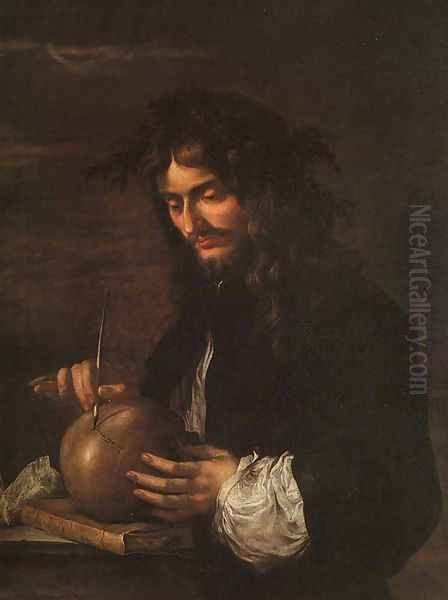
Rosa's thematic repertoire was as distinctive as his style, reflecting his fascination with the unconventional, the philosophical, and the dramatic aspects of human existence.
Bandits and Soldiers: A recurring motif in Rosa's work is the figure of the bandito (bandit) or soldier, often depicted lurking in wild landscapes or engaged in skirmishes. This interest may stem partly from the influence of battle painters like Aniello Falcone and perhaps the prints of Jacques Callot, but Rosa imbued these figures with a particular romantic aura. They represented freedom from societal constraints, a life lived on the edge, mirroring his own rebellious spirit. His famous series of small etchings, the Figurine, masterfully captures the dynamic poses and rugged character of these soldiers and common folk.
Witchcraft and the Occult: Rosa frequently explored themes of witchcraft, magic, and the supernatural. His paintings and prints of witches' sabbaths, such as the famous Witches at their Incantations, are filled with grotesque figures, eerie nocturnal settings, and a palpable sense of dark magic. While reflecting a broader Baroque interest in the bizarre and macabre, Rosa's treatment often seems tinged with satire, perhaps critiquing superstition or using the theme as a vehicle for exploring darker psychological states. These works stand out for their imaginative power and departure from traditional religious or mythological subjects.
Philosophers and Hermits: Contrasting with the scenes of violence and sorcery are Rosa's numerous depictions of solitary figures contemplating in the wilderness. Ancient philosophers like Democritus (often shown meditating amidst ruins) or Diogenes, and Christian hermits like St. John the Baptist, St. Paul the Hermit, or St. Mary Magdalene, find refuge and enlightenment far from the corrupting influence of society. These works reflect Rosa's engagement with Stoic philosophy, themes of melancholy (perhaps influenced by Northern prints like Albrecht Dürer's Melencolia I), the vanity of worldly pursuits, and the search for wisdom in solitude and nature.
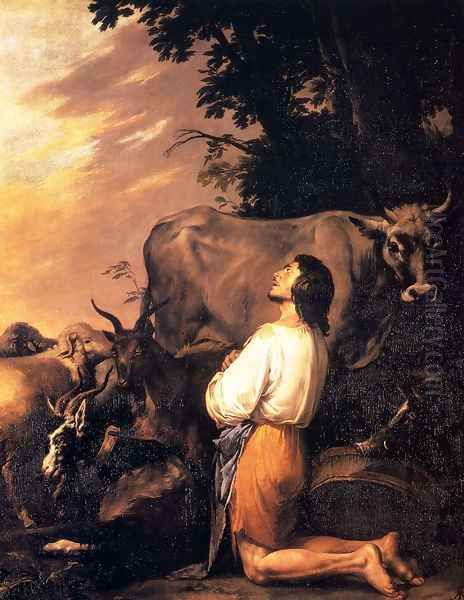
History and Mythology: Rosa also tackled large-scale history and mythological paintings, though often choosing subjects that allowed for dramatic intensity and moral commentary. Works like The Conspiracy of Catiline, The Death of Regulus, or The Shade of Samuel Appearing to Saul focus on moments of crisis, betrayal, stoic endurance, or supernatural confrontation. His approach differed from the grand allegories of contemporaries like Pietro da Cortona or the classical restraint of Andrea Sacchi, often emphasizing the darker, more violent, or psychologically disturbing aspects of the narratives.
Master Printmaker
Beyond his paintings, Salvator Rosa was a highly accomplished and influential printmaker, primarily working in etching. Printmaking offered him a means to disseminate his compositions and ideas more widely and perhaps with greater independence from patrons than large-scale painting allowed. He produced over eighty etchings during his career, showcasing remarkable technical skill and expressive power.
His most famous series of prints is the Figurine, comprising around sixty small etchings depicting soldiers, bandits, and ordinary people in dynamic poses. These prints were immensely popular and influential, admired for their lively characterization and vigorous linework. They served as models for countless artists and contributed significantly to the romantic image of Rosa himself.
Other significant prints explore his characteristic themes: philosophical contemplation (Democritus in Meditation, Diogenes Casting Away his Bowl), allegory (The Genius of Salvator Rosa, asserting his independence), mythology, and scenes of witchcraft. His etchings often possess an immediacy and energy that complements his paintings, utilizing bold contrasts of light and dark and expressive lines to convey mood and drama. His innovative approach to etching influenced later printmakers, notably the great Venetian artist Giovanni Battista Piranesi, whose dramatic views of Roman ruins share a kindred spirit with Rosa's wild landscapes and sense of sublime decay.
Anecdotes and Legends
Salvator Rosa's life and personality were such that they naturally attracted stories and legends, some based in fact, others embellished over time. These anecdotes contributed significantly to his posthumous reputation, particularly among the Romantics who admired his rebellious spirit.
One persistent legend connects Rosa with bandits during his youth, suggesting he spent time living among them in the wilds of the Abruzzi region. This story, popularized by later biographers like Lady Morgan in the 19th century, fueled the image of Rosa as a "savage" painter intimately familiar with the untamed life he depicted. While he certainly traveled through rugged areas and depicted bandits frequently, concrete evidence for him actually being part of a bandit group is lacking and often disputed by modern historians.
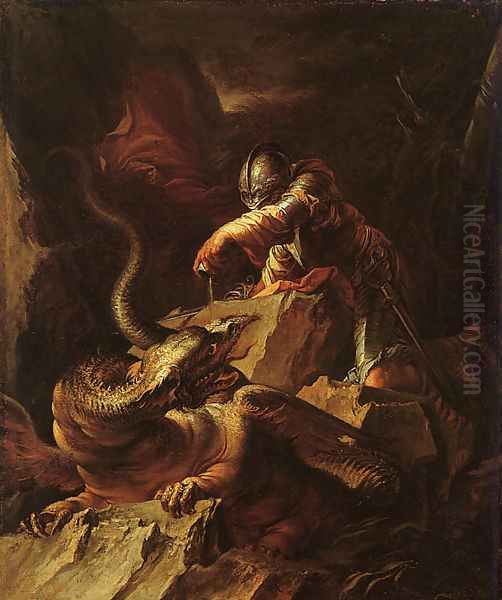
His documented involvement in the Masaniello revolt – a popular uprising against Spanish rule in Naples in 1647 – is more historically grounded, though the extent and nature of his participation remain debated. Some accounts claim he belonged to a militant group called the "Compagnia della Morte," allegedly involved in ambushing Spaniards, but this too is often viewed with skepticism. What is clear is that the turbulent events in Naples likely impacted him and reinforced his critical view of authority.
Other tales verge on the fantastical, such as the story that he visited the underworld and witnessed the torment of ancient poets, supposedly stemming from a period of solitary retreat. Whether factual or purely mythical, these stories underscore the perception of Rosa as an extraordinary individual, deeply engaged with profound questions of life, death, and the nature of reality, living a life as dramatic and unconventional as his art.
Influence and Legacy
Salvator Rosa's influence unfolded gradually and selectively, peaking long after his death. During his lifetime, his unique style and defiant personality set him apart from the mainstream Roman Baroque, dominated by the classicism of artists like Carlo Maratta. While respected, and perhaps feared, for his talent and intellect, he did not establish a large school of direct followers in the way some other major figures did.
His reputation began to grow significantly in the 18th century, particularly in Britain. British travelers on the Grand Tour encountered his works in Italy and brought back paintings and prints. His wild landscapes resonated with the developing aesthetic sensibilities of the Picturesque and the Sublime, theorized by writers like Edmund Burke. British landscape painters such as Richard Wilson and Alexander Cozens drew inspiration from his dramatic compositions and depictions of untamed nature. Collectors and connoisseurs like Horace Walpole admired his work, seeing in it an exciting alternative to the calmness of Claude Lorrain.
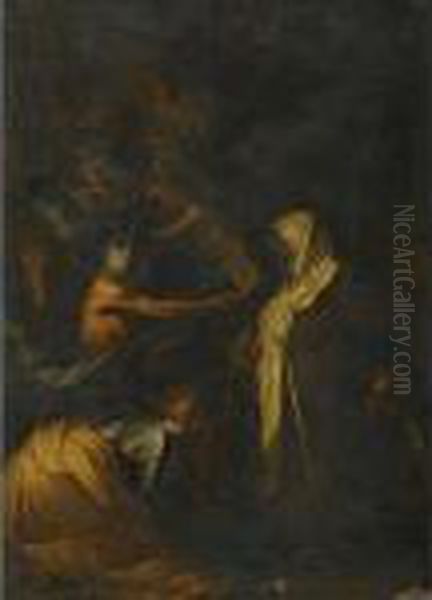
The true zenith of Rosa's influence arrived with the Romantic movement in the late 18th and early 19th centuries. The Romantics saw Rosa as a proto-Romantic hero: an individualist who defied convention, celebrated untamed nature, explored strong emotions, and delved into themes of melancholy, rebellion, and the supernatural. Painters like J.M.W. Turner and John Martin echoed his sense of the sublime and his dramatic use of light and landscape. Writers across Europe, including Lord Byron, Percy Bysshe Shelley, Ann Radcliffe in England, and Victor Hugo, Théophile Gautier, Honoré de Balzac, and Stendhal in France, were captivated by his art and the legends surrounding his life. Gautier famously dubbed him a "precursor of French Romanticism." Lady Morgan's highly romanticized (and often inaccurate) biography, The Life and Times of Salvator Rosa (1824), cemented his image as the quintessential Romantic artist for a wide audience.
While his critical fortunes have fluctuated since the 19th century, with some later critics dismissing his work as overly theatrical or repetitive, Salvator Rosa's position in art history remains secure. He is recognized for his powerful originality, his pioneering role in the development of landscape painting towards Romanticism, and his compelling embodiment of the independent, multi-talented artist.
Major Works and Collections
Salvator Rosa left behind a substantial body of work, including paintings, drawings, and etchings. Among his most celebrated masterpieces are:
Allegory of Fortune (c. 1658-59): A large, controversial painting criticizing the arbitrary nature of fortune and papal patronage (J. Paul Getty Museum, Los Angeles).
The Conspiracy of Catiline (c. 1663): A dramatic history painting depicting the Roman conspirators taking an oath (Palazzo Martelli, Florence).
Witches at their Incantations (or Witches' Sabbath) (c. 1646): A quintessential example of his exploration of the occult and the grotesque (National Gallery, London).
Landscape with Tobias and the Angel (c. 1660-70): A characteristic landscape where the biblical figures are enveloped by wild, sublime nature (National Gallery, London).
Democritus in Meditation (c. 1650-51): A poignant depiction of the ancient philosopher contemplating mortality amidst ruins (Statens Museum for Kunst, Copenhagen).
Self-Portrait (c. 1647): Presenting himself as a proud philosopher-artist (Metropolitan Museum of Art, New York).
The Figurine Series (c. 1656-57): Influential etchings of soldiers and common folk.
His works are housed in major museums across the world. Significant collections can be found in:
The Pitti Palace and Uffizi Gallery, Florence
The Capodimonte Museum, Naples
The Louvre Museum, Paris
The National Gallery, London
The Wallace Collection, London
The Dulwich Picture Gallery, London
The Metropolitan Museum of Art, New York
The Los Angeles County Museum of Art (LACMA)
The Kimbell Art Museum, Fort Worth
The Nationalmuseum, Stockholm
The Staatliche Kunsthalle, Karlsruhe
The Kunsthistorisches Museum, Vienna
These collections testify to the enduring appeal and historical significance of his art, showcasing the breadth of his talent from dramatic landscapes and seascapes to history paintings, philosophical subjects, and masterful prints.
Conclusion: A Bridge Between Eras

Salvator Rosa occupies a unique and pivotal position in the history of European art. Rooted in the dramatic realism and emotional intensity of the Neapolitan Baroque, he forged a path distinctly his own, characterized by a fascination with the wild, the untamed, and the sublime aspects of nature and the human psyche. His rejection of idealized beauty in favor of rugged power, his exploration of unconventional themes like witchcraft and banditry, and his cultivation of a fiercely independent, multi-talented persona set him apart from his contemporaries.
While perhaps not fully appreciated by the mainstream arbiters of taste during his lifetime, his legacy proved profound. He became a crucial precursor to the Romantic movement, offering inspiration through his dramatic landscapes, his rebellious spirit, and the very legends that grew around his life. He stands as a bridge between the theatrical energy of the Baroque and the emotional subjectivity and awe of nature that would define Romanticism. Salvator Rosa remains a compelling figure – the "savage" genius, the painter of storms and solitude, whose wild heart continues to resonate through his powerful and evocative art.